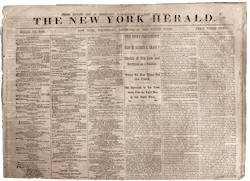January 14, 1861, The New York Herald
TO THE EDITOR OF THE HERALD.
BROOKLYN, Jan. 8, 1861.
There is considerable hue and cry in the papers about there not being any available vessels, of light draught, which the President could order to Charleston should he desire to do so. This is unnecessary, as there are no less than eight revenue cutters scattered along the coast from Norfolk, Va., to Eastport, Me. These vessels range from one hundred and fifty to six hundred tons, and if manned and equipped, as allowed by the Revenue act of 1799, would render good service when called upon. The law referred to allows men, including non-commissioned officers, gunners, and marines;” but at present none of them, except the Harriet Lane, which has her war complement on board, has more than fifteen or twenty seamen attached. There would be no difficulty in getting full crews for the whole of them in a very short time if government desired, as there are plenty of seamen unemployed at present. If these cutters were fully armed and manned, the government would have at its command eight handy vessels, of light draught, carrying about twenty-five guns and five hundred and sixty men. This is a force of no ordinary account in these times, and there is no reason why these cutters should not be ordered to the Brooklyn Navy Yard to fit out at once. Even if they are not needed, there would be no harm done to have them armed and manned as the law allows. It would, at least, give employment to a few of our mechanics and seamen, which of itself, during these hard times, would justify the government in putting the vessels in sea trim. In 1832 General Jackson sent a fleet of eight or nine revenue cutters to Charleston, and employed them against the nullifiers with good effect. Why should they not be used now as they were then? If the cutter William Aiken, at Charleston, had been armed and manned, as she should have been, the lieutenants could have made resistance against her traitorous captain, and those who assisted him, placed the vessel under Major Anderson’s guns at Fort Sumter, and saved the United States the disgrace of having had its public armed cruisers captured by the revolutionists. No delay should be permitted in attending to putting the revenue cutters in condition for service, so that their cress would have time to be exercised at the guns before being called upon for active duty.
The following is a list of the revenue cutters referred to above. They are all sailing vessels, schooner rigged, except the Harriet Lane, which is a steamer: –
Duane, Captain Evans, stationed at Norfolk, Va., and almost a new vessel.
Forward, Captain Nones, stationed at Wilmington, Del., an old vessel, and carries two guns.
Harriet Lane, Captain Faunce, stationed at New York, is a new ship, propelled by steam, carries four 24 pound Dahlgreen side guns, with a long 32 pound pivot gun forward, and a full crew.
James Campbell, Captain Clarke, stationed at New London, Conn., nearly new, carries one 32 pound pivot gun, and is pierced for four side guns.
Morris, Captain Whitcomb, stationed at Boston, is an old vessel, and carries two 12 pound guns.
Caleb Cushing, Captain Walden, stationed at Portland, Me., hull in good condition, is pierced for four side guns, and could carry a pivot gun, but only has one 12 pounder on board.
Jackson, Captain Carson, stationed at Eastport, Me., hull good; carries two 12 pound guns and a good name.
